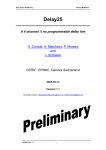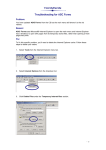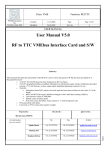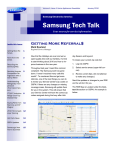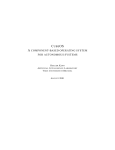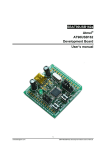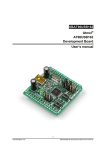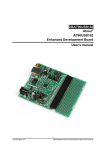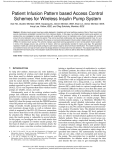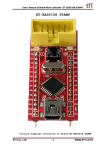Download QPLL User Manual
Transcript
D E L AY 2 5 M AN U AL P R E L I M I N AR Y Delay25 A 4 channel ½ ns programmable delay line H. Correia, A. Marchioro, P. Moreira and J. Schrader CERN - EP/MIC, Geneva Switzerland 2004-12-15 Version 1.0 Technical inquires: [email protected], [email protected] VERSION 1.0 1 D E L AY 2 5 M AN U AL P R E L I M I N AR Y Introduction__________________________________________________ 4 Features: .............................................................................................................................4 OPERATION _________________________________________________ 4 Operating the ASIC ___________________________________________ 6 IO mode ...............................................................................................................................6 I2C register access ............................................................................................................6 Control registers ................................................................................................................6 Channel control registers CR0, CR1, CR2, CR3 and CR4 ...........................................7 General control register GCR ........................................................................................7 Timing..................................................................................................................................8 pinout_______________________________________________________ 8 References __________________________________________________ 9 VERSION 1.0 2 D E L AY 2 5 M AN U AL P R E L I M I N AR Y Summary of Changes Version 1.0: • First release of the Delay25 manual 2004-12-15 VERSION 1.0 3 D E L AY 2 5 M AN U AL P R E L I M I N AR Y INTRODUCTION The Delay25 is a 5 channel CMOS programmable delay line featuring 4 channels that allow to phase delay periodic or non-periodic digital signals and a master channel that can be used to phase delay a clock signal. The master channel serves as a calibration reference. The phase of each channel can be independently programmed with a resolution of 0.5 ns through an I2C interface [1]. The reference clock frequency can be any of the following: 32, 40, 64 or 80 MHz. The ASIC is manufactured in a 0.25 µm CMOS radiation tolerant technology. Features: • 0.25 µm CMOS technology • Radiation tolerant • Self calibrating • Reference clock frequencies: 32, 40, 64 or 80 MHz • Phase resolution: 0.5 ns • Output jitter: < xxxxxx ps • Programmable I/O: o CMOS 2.5V o LVDS • Supply voltage: 2.5 V • Package: TQFP32 OPERATION A block diagram of the delay25 ASIC is shown in Figure 1. The ASIC contains a master Delay Locked Loop (DLL), four Replica Delay Lines (RDL), an I2C interface and double standard I/O input and output buffers. In the circuit, the DLL serves as a control element for the replica delay lines. In short, a delay locked loop is a control loop that regulates the total propagation delay of a clock signal across a voltage controlled delay line. The control loop assures that the total propagation delay is exactly equal to a clock period (or a multiple of it). By taping the signal along the delay line at regular intervals it is possible to obtain precisely calibrated delays which are a fraction of the clock period. Since the DLL uses a reference clock to calibrate the total propagation delay its operation is rendered independent of the fabrication process parameters, temperature and power supply voltage (within the operation ranges). The four replica delay lines are physically made as exact copies of the voltage controlled delay line that is part of the DLL. Under these conditions, and due to the good matching that is possible to obtain in integrated circuits, when the control voltage produced by the DLL is applied to the replica delay lines, their total propagation delay will be identical to that of the master delay line. Again, by taping these replica delay lines at periodic intervals it is possible to obtain calibrated delays which are a fraction of the reference clock period. There are two main differences between the master and the replica delay lines: first, the master delay line is part of a control loop, that is, its total delay is constantly monitored and corrected, while the replica delay lines are working open loop. Second, VERSION 1.0 4 D E L AY 2 5 M AN U AL P R E L I M I N AR Y the master delay line requires a periodic (clock) signal for correct operation of the control loop while the replica delay lines can be used with non-periodic signals (pulses) since they are working open loop. As said before calibration of the replica delay lines depends on matching, which for integrated circuits is normally quite good but not exactly perfect. This means that the total delay of the replica delay lines is not going to be exactly equal to that of the master and so there will be some small errors introduced. However, these errors should be well with the system requirements and specifications. In0 Replica Delay Line In0 Out0 Out0 Replica Delay Line In1 D0 In1 Out1 D1 Out1 Master DLL CLKIN ClockIn CLKOUT ClockOut Replica Delay Line In2 In2 Out2 Out2 Replica Delay Line In3 D2 In3 Out3 Out3 IOMODE Delay25 DC I2C Interface D3 D0, D1, D2 D3 and DC are independently programable delays I2C Bus I2C Address Figure 1 Block diagram of the delay25 (left) and hypothetical use of the ASIC illustrating the meaning of the phase delay for each channel (right) Figure 1 (right) illustrates a possible use of the delay25 chip and the meaning of phase delay for each channel. As mentioned before, please note that the master channel can be only used with a clock signal having clock frequencies of 32, 40, 64 or 80 MHz. The IOMODE configuration pin allows the ASIC to operate with either CMOS (2.5V) or LVDS [2] levels. The reset and I2C related pins are not affected by the IOMODE signal. VERSION 1.0 5 D E L AY 2 5 M AN U AL P R E L I M I N AR Y OPERATING THE ASIC The ASIC operation is controlled by the IOMODE pin and by means of four internal registers, which can be accessed through an I2C bus. IO mode The IO signal levels are controlled by the pin IOMODE (IO mode) as is indicated in Table 1. As represented in Figure 1 the IO mode pin affects only the input and output buffers of the replica and master delay lines. When the IO mode is set to CMOS (0) all the channels inputs and outputs work single ended being all the negative inputs and outputs disabled. When IO mode is set to LVDS (1) all the channels inputs and outputs are differential. Table 1 IO modes IOMODE Function 0 CMOS 2.5 V 1 LVDS I2C register access The ASIC registers are accessed through the I2C bus which is composed of the following signals: SCL (serial clock), SDA (serial data) and the address pins I2CA<6:3> which correspond to the four most significant bits of the I2C address (these act a chip select address). The three least significant bits of the I2C address are internally decoded and map into the ASIC internal register as shown in Table 2. Table 2 Internal I2C register map I2C Address Name Function 0 CR0 Control register for channel 0 1 CR1 Control register for channel 1 2 CR2 Control register for channel 2 3 CR3 Control register for channel 3 4 CR4 Control register for clock channel 5 GCR General control register 6 Unused - 7 Unused - Control registers Five register control the operation of the Delay25 ASIC. Each channel is individually controlled by its control register (CR0 to CR4). A general control register (GCR) controls global parameters for all the five channels, the DLL and the logic. VERSION 1.0 6 D E L AY 2 5 M AN U AL P R E L I M I N AR Y Channel control registers CR0, CR1, CR2, CR3 and CR4 The bit allocation of each channel control register is as given in Table 3. Bits Del<5:0> control the delay for each channel and the Enable bit enables the channel output. Upon a reset, bit Enable and bits Del<5:0> are cleared. Table 3 Control registers (CR0 to CR4) bit allocation B7 B6 B5 B4 B3 B2 B1 B0 n.u. Enable Del<5> Del<4> Del<3> Del<2> Del<1> Del<0> Function n.u. 0 0 0 0 0 0 0 Reset State General control register GCR The general control register GCR controls the operation of the Delay-Locked Loop (DLL) and allows to reset the DLL or the ASIC via the I2C interface. The bit allocation for this register is given in Table 4 Table 4 General Control Register (GCR) bit allocation B7 B6 B5 B4 B3 B2 B1 B0 GRST IDLL n.u. n.u n.u. n.u. M<1> M<0> Function 0 0 - - - - Not Not Reset State cleared cleared The ASIC can operate with for different clock frequencies (32, 40, 64 and 80 MHz). Correct operation of the ASIC requires bits M<1:0> of the control register to be set to the appropriate mode. The settings of these bits should be made according to Table 5. Bits M<1:0> are not affected by a reset. Table 5 Clock modes M<1> M<0> Clock Frequency [MHz] 0 0 40 0 1 80 1 0 32 1 1 64 IDLL: bit IDLL is used to force the resynchronization of the DLL without resetting the chip. Writing a “1” to this bit forces the resynchronization of the DLL. This bit always reads as a “0” GRST: bit GRST is used to reset the ASIC and force the synchronization of the DLL. The action of this bit is similar to a hardware reset. That is, the contents of the control register are cleared but the contents of the general control register remains unchanged (clock mode bits unaffected). This bit always reads back as a “0”. VERSION 1.0 7 D E L AY 2 5 M AN U AL P R E L I M I N AR Y Timing Data in preparation PINOUT The ASIC is package in a 32 pin TQFP package. Pins are assigned as indicated in Table 6. Table 6 Pins assignments Pin number Pin name IO levels Function 1 Vdd +2.5 V Power 2 SCL CMOS I2C serial clock 3 SDA CMOS – open drain I2C serial data 4 I2CA6 CMOS I2C Address 5 I2CA5 CMOS I2C Address 6 I2CA4 CMOS I2C Address 7 I2CA3 CMOS I2C Address 8 GND 0V Ground 9 OUT0+ LVDS/CMOS Channel 0 +output 10 OUT0- LVDS Channel 0 -output 11 OUT1+ LVDS/CMOS Channel 1 +output 12 OUT1- LVDS Channel 1 -output 13 OUT2+ LVDS/CMOS Channel 2 +output 14 OUT2- LVDS Channel 2 -output 15 OUT3+ LVDS/CMOS Channel 3 +output 16 OUT3- LVDS Channel 3 -output 17 Vdd 2.5 V Power 18 IOMODE CMOS IO mode select 19 ResetZ CMOS Reset – active low 20 CLKOUT- LVDS Clock channel 4 -output 21 CLKOUT+ LVDS/CMOS Clock channel 4 +output 22 CLKIN- LVDS Clock channel 4 -input 23 CLKIN+ LVDS/CMOS Clock channel 4 +input 24 GND 0V Ground 25 IN3- LVDS Channel 3 -input 26 IN3+ LVDS/CMOS Channel 3 +input 27 IN2- LVDS Channel 2 -input VERSION 1.0 8 D E L AY 2 5 M AN U AL P R E L I M I N AR Y 28 IN2+ LVDS/CMOS Channel 2 +input 29 IN1- LVDS Channel 1 -input 30 IN1+ LVDS/CMOS Channel 1 +input 31 IN0- LVDS Channel 0 -input 32 IN0+ LVDS/CMOS Channel 0 +input REFERENCES [1] The I2C-BUS Specification: http://www.semiconductors.philips.com/acrobat_download/literature/9398/39340011.pdf [2] See for example: http://www.national.com/an/AN/AN-971.pdf VERSION 1.0 9









